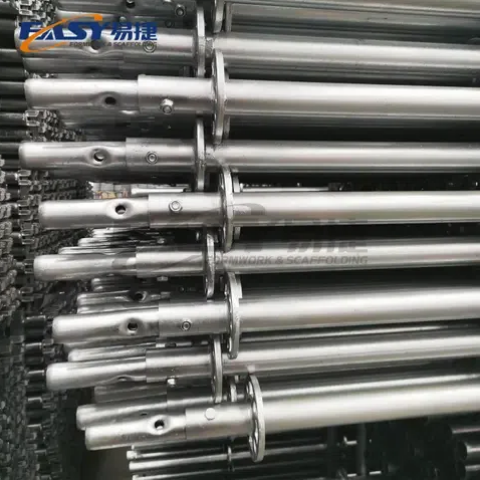English 

T: +86-18842539857
E: anniescaffolding@163.com
E: anniescaffolding@163.com
Room No.203, Building No.5, Huijin Plaza, West Fifth Road No.35, Tianjin Airport Economic Zone, Tianjin, China

Views: 0 Author: Site Editor Publish Time: 2025-09-29 Origin: Site









Safety is never negotiable on a construction site, and scaffolding systems stand at the heart of ensuring that projects are completed efficiently while protecting workers at height. Among the many systems available, Ringlock Scaffolding is often highlighted for its advanced design and compliance with international scaffold safety standards. Understanding why this system is considered safer requires a closer look at its features, certifications, inspection routines, and best practices that support safe usage. For companies and site managers seeking both compliance and reliability, Tianjin Easy Scaffolding provides solutions that balance durability, adaptability, and above all, worker protection.
When evaluating any scaffolding solution, safety features are the first consideration. Ringlock Scaffolding is designed with practical innovations that directly enhance safety for workers at height.
The rosette connection system is the defining characteristic of Ringlock. Each rosette allows multiple components to connect at a single point, secured with wedge heads that lock tightly into position. This eliminates the risk of loose joints, while also speeding up assembly. With secure engagement at every level, the structure maintains consistent rigidity under various loads, reducing the likelihood of collapse or accidental shifts.
Ringlock components are designed with built-in attachment points that allow workers to fasten harnesses securely. This design consideration ensures that fall protection equipment integrates seamlessly with the scaffolding, rather than relying on improvised anchorage that may not meet safety standards.
One of the most effective safety aspects of Ringlock is how it supports phased guardrail installation. During assembly, horizontal ledgers and guardrails can be fixed early in the process, ensuring that workers are protected against falls even before the full structure is complete. This “protection while building” approach sets Ringlock apart from older systems where guardrails could only be installed after full height was reached.
Purchasers and site managers should never assume a scaffold is compliant just because it looks sturdy. Independent standards exist to confirm structural safety, load capacity, and proper design. When choosing Ringlock Scaffolding, it is critical to verify certification against internationally recognized safety benchmarks.
These standards define performance requirements for facade scaffolds and temporary works equipment. They cover load classes, structural design, and material quality. Meeting EN12810/EN12811 ensures the system can withstand both static and dynamic forces common on European construction sites.
This standard is specific to the Australasian market and focuses on materials, structural performance, and safe access. Compliance demonstrates suitability for projects in regions with strict workplace safety enforcement.
This American standard outlines safety requirements for scaffolding used in the construction industry. It emphasizes assembly methods, access, guardrails, and component strength. For buyers in North America, ensuring that Ringlock meets A10.8 is a prerequisite for passing safety inspections.
By demanding proof of these certifications from suppliers, safety officers guarantee that the scaffolding system is not only engineered well but also independently tested and approved for real-world applications.

Even the best-designed scaffolding must be verified at the point of use. Before a structure is declared safe for workers, inspections should cover the following key areas:
Each rosette and joint must be checked for smooth, defect-free welds. Cracks or incomplete welds may compromise structural integrity.
Inspectors should verify that rosettes are not deformed and that ledgers engage fully with the wedge locks. Partial engagement may create dangerous weak points.
Steel or metal planks should sit flush without gaps or rocking. Secure locking systems ensure planks cannot shift under foot traffic or heavy loads.
The scaffold’s stability begins at ground level. Base plates must rest on firm, level ground or adjustable jacks. Missing or tilted base plates are a frequent cause of scaffold accidents.
A clear scaffold tagging system should be used to identify whether the structure has passed inspection, needs maintenance, or is unsafe. Documentation of inspections reinforces accountability and compliance.
This pre-use checklist is an essential habit that ensures even the highest quality Ringlock Scaffolding remains safe in daily operation.
No system is immune to misuse or poor manufacturing. Understanding common failure points helps managers and crews prevent avoidable accidents.
If wedges are not fully hammered into position, connections may appear stable but lack full strength. Training crews to check each lock carefully reduces this risk.
Mixing parts from different suppliers can compromise safety, since tolerances may vary slightly. Always source complete systems from a trusted manufacturer like Tianjin Easy Scaffolding, where quality and compatibility are guaranteed.
Scaffold components exposed to harsh weather may corrode if galvanizing is thin or inconsistent. Over time, corrosion weakens steel, leading to sudden failures. Choosing suppliers with strong QA processes ensures coating thickness and quality meet international standards.
Through careful procurement and routine inspection, these failure points can be eliminated before they create hazards on site.
Safe scaffolding relies not only on the system itself but also on how workers use it. Proper training and assembly sequencing are crucial to maximize the advantages of Ringlock Scaffolding.
Workers should be trained to install ledgers and guardrails as early as possible, ensuring that fall protection is active even during construction. This staged method reduces exposure to open edges.
Harnesses and lanyards should always be connected to designated attachment points on the scaffold. Crews must be instructed never to use improvised tie-offs, as this may reduce load resistance during a fall.
Formal training sessions should cover not only assembly instructions but also hazard awareness, safe load distribution, and inspection routines. Companies that invest in training see fewer accidents and higher productivity.
With proper training, Ringlock systems become not only easier to use but significantly safer, ensuring compliance with scaffold safety standards worldwide.
Ringlock Scaffolding delivers more than just structural flexibility—it is a system designed with safety as a priority, from its rosette locking mechanics to its compatibility with international scaffold safety standards. By verifying certifications, conducting thorough inspections, addressing common failure points, and training workers in safe assembly practices, construction firms can significantly reduce risks on site. At Tianjin Easy Scaffolding, every product undergoes strict quality control and meets recognized safety benchmarks, ensuring our partners receive reliable solutions that protect both workers and projects. To learn more about our Ringlock Scaffolding or to request test certificates and load-test reports, contact us today.